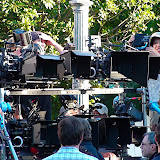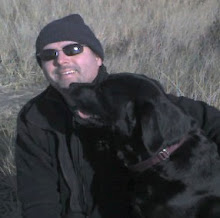2009 Camera Assessment Series
Back in December & January, I volunteered to work on a rather historic shoot being produced in conjunction with Revelations Entertainment, the Producers Guild of America, and the American Society of Cinematographers.
As the PGA has finally started to release publicity about it being a part of their 2009 "Produced By" conference, now is a great time to finally release some of the behind-the-scenes photos from the production.
The link above is to a Picasa Album of the pics - though I've not yet had time to caption them - I'll try to over the next few weeks.
The shoot itself was really quite interesting, and we assessed both the physical production and the image capture performances of eight cinema cameras. The cameras were selected based upon their common ability to capture 4:4:4 10 bit images, and deliver 4:4:4 10-bit DPX files for DI and film outs. (which is the reason a number of other excellent cameras, such as the Sony PWM-EX3 were left out - it can "only" record 4:2:2).
The cameras in the test included:
- Arri 435 film camera (various Kodak film stocks, but primarily 5217)
- Arri D21 digital camera
- Panavision Genesis digital camera (based on the same sensor as the Sony F35)
- Panasonic 3700 digital camera
- RED One digital camera
- Sony F23 digital camera
- Sony F35 digital camera
- Thomson Viper
Some cameras were tethered to decks, some had their own on board storage, some used tape. The full results of the test, as covered by ASC members from the whitepaper perspective, and from the production and narrative side by nine field teams of documentary filmmakers (which I produced, along with PGA member Michael Shores), will be presented this summer, and then be archived in the libraries of the Academy of Motion Picture Arts & Sciences, the American Society of Cinematographers, and the Producers Guild of America.
We took each camera from delivering 10 bit DPX files, (and conversions from native capture files such as with RED RAW) to Laser Pacific for both one-light and fully-windowed Digital Intermediate passes, which are then being finaled as DCP (digital cinema packages) and as filmed out negatives.
The results of the tests really showed that producers and DP's alike face a growing need to consider not only the aesthetics and the budget of their shows, but the workflows in production and post production in terms of extra time transcoding or managing data.
Anyone interested in the results should really check out the upcoming conference, and I hope that eventually the PGA and ASC will make the documentary (for which we shot over 100 hours of footage) and the white papers accessible online.
As the PGA has finally started to release publicity about it being a part of their 2009 "Produced By" conference, now is a great time to finally release some of the behind-the-scenes photos from the production.
 |
| 2009 PGA-ASC Camera Assessment Series |
The link above is to a Picasa Album of the pics - though I've not yet had time to caption them - I'll try to over the next few weeks.
The shoot itself was really quite interesting, and we assessed both the physical production and the image capture performances of eight cinema cameras. The cameras were selected based upon their common ability to capture 4:4:4 10 bit images, and deliver 4:4:4 10-bit DPX files for DI and film outs. (which is the reason a number of other excellent cameras, such as the Sony PWM-EX3 were left out - it can "only" record 4:2:2).
The cameras in the test included:
- Arri 435 film camera (various Kodak film stocks, but primarily 5217)
- Arri D21 digital camera
- Panavision Genesis digital camera (based on the same sensor as the Sony F35)
- Panasonic 3700 digital camera
- RED One digital camera
- Sony F23 digital camera
- Sony F35 digital camera
- Thomson Viper
Some cameras were tethered to decks, some had their own on board storage, some used tape. The full results of the test, as covered by ASC members from the whitepaper perspective, and from the production and narrative side by nine field teams of documentary filmmakers (which I produced, along with PGA member Michael Shores), will be presented this summer, and then be archived in the libraries of the Academy of Motion Picture Arts & Sciences, the American Society of Cinematographers, and the Producers Guild of America.
We took each camera from delivering 10 bit DPX files, (and conversions from native capture files such as with RED RAW) to Laser Pacific for both one-light and fully-windowed Digital Intermediate passes, which are then being finaled as DCP (digital cinema packages) and as filmed out negatives.
The results of the tests really showed that producers and DP's alike face a growing need to consider not only the aesthetics and the budget of their shows, but the workflows in production and post production in terms of extra time transcoding or managing data.
Anyone interested in the results should really check out the upcoming conference, and I hope that eventually the PGA and ASC will make the documentary (for which we shot over 100 hours of footage) and the white papers accessible online.
Labels: American Society of Cinematography, AMPAS, cinematography, digital cinema, Producers Guild of America


5 Comments:
Where do I get more info on this? When is the Assessment coming out?
As noted, the Producers Guild is doing a presentation of the results at the "Produced By" conference next month in Los Angeles.
After that, the white papers and the full documentary will likely be kept at the libraries of AMPAS, PGA, and ASC by the end of this year.
Since it's an all-volunteer effort, putting all the data together is a very, very slow process.
I've also been pushing to release the data and docu online, but so far the leadership of the Guilds has been very reticent to do so... unfortunately.
I'll post here again about results when they are released.
There is a plan to produce a Blu-Ray disc of the CAS material. There is quite a bit of controversy regarding "letting the disc out in the open" More people should speak up and encourage the release of the Blu-Ray in order that Producers, Directors and DP's far and wide have an opportunity to view the results and thereby make more informed decisions. Of course a "Terms of Use" agreement could and should be part of the Blu-Ray release
I guess what's not clear to me is the reasoning behind the controversy. What is clear is that the more we try to exclude fans and enthusiasts from what we do and how we do it, the less reason we give them to either create their own art using these tools, or less reason to buy our product (movies) when they come out.
Secrecy for the sake of secrecy doesn't work well in a world that contains the Internet, and we couldn't and shouldn't wish it weren't so.
I saw this at the Produced by conference and thought it was awesome. Objective, clear, and concise. As a director, my eyes were opened to the possibities and capabilities, particularly with the Panavision Genesis. As others have noted on this blog, why the presentation would be kept 'secret' and not available for wide release - even on YouTube - is beyond me.
That aside though, I commend and thank all involved in the creation of the Camera Assessment series.
Post a Comment
<< Home